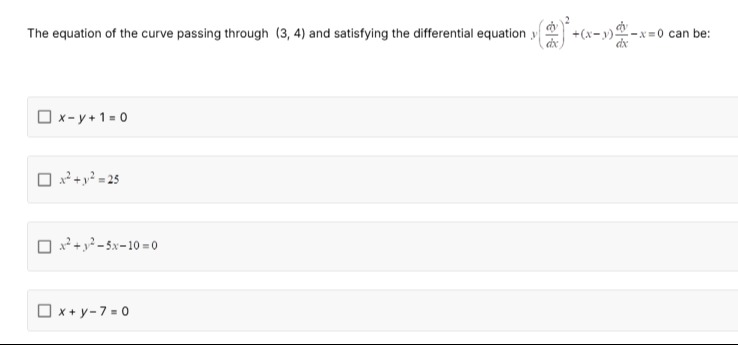Question
Question: The equation of the curve passing through (3, 4) and satisfying the differential equation $y\left(\f...
The equation of the curve passing through (3, 4) and satisfying the differential equation y(dxdy)2+(x−y)dxdy−x=0 can be:

x-y+1=0
x^2+y^2 = 25
x^2+y^2-5x-10=0
x+y-7 = 0
x-y+1=0, x^2+y^2 = 25
Solution
The given differential equation is y(dxdy)2+(x−y)dxdy−x=0. Let p=dxdy. The equation becomes yp2+(x−y)p−x=0. Factoring this quadratic in p, we get yp2+xp−yp−x=0, which simplifies to p(yp+x)−1(yp+x)=0, or (p−1)(yp+x)=0.
This yields two cases:
Case 1: p−1=0⟹dxdy=1. Integrating, we get y=x+C1. Since the curve passes through (3, 4), we substitute these values: 4=3+C1, which gives C1=1. Thus, the equation of the curve is y=x+1, or x−y+1=0.
Case 2: yp+x=0⟹yp=−x⟹dxdy=−yx. This is a separable differential equation: ydy=−xdx. Integrating both sides, we get ∫ydy=∫−xdx, which results in 2y2=−2x2+C2. Multiplying by 2, we get y2=−x2+2C2, or x2+y2=2C2. Let K=2C2. So, the equation is x2+y2=K. Since the curve passes through (3, 4), we substitute these values: 32+42=K, which gives 9+16=K, so K=25. Thus, the equation of the curve is x2+y2=25.
Both x−y+1=0 and x2+y2=25 are valid equations for curves passing through (3, 4) and satisfying the given differential equation.
